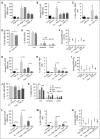Analysis of Jak2 signaling reveals resistance of mouse embryonic hematopoietic stem cells to myeloproliferative disease mutation
- PMID: 26864339
- PMCID: PMC4882783
- DOI: 10.1182/blood-2015-08-664631
Analysis of Jak2 signaling reveals resistance of mouse embryonic hematopoietic stem cells to myeloproliferative disease mutation
Abstract
The regulation of hematopoietic stem cell (HSC) emergence during development provides important information about the basic mechanisms of blood stem cell generation, expansion, and migration. We set out to investigate the role that cytokine signaling pathways play in these early processes and show here that the 2 cytokines interleukin 3 and thrombopoietin have the ability to expand hematopoietic stem and progenitor numbers by regulating their survival and proliferation. For this, they differentially use the Janus kinase (Jak2) and phosphatidylinositol 3-kinase (Pi3k) signaling pathways, with Jak2 mainly relaying the proproliferation signaling, whereas Pi3k mediates the survival signal. Furthermore, using Jak2-deficient embryos, we demonstrate that Jak2 is crucially required for the function of the first HSCs, whereas progenitors are less dependent on Jak2. The JAK2V617F mutation, which renders JAK2 constitutively active and has been linked to myeloproliferative neoplasms, was recently shown to compromise adult HSC function, negatively affecting their repopulation and self-renewal ability, partly through the accumulation of JAK2V617F-induced DNA damage. We report here that nascent HSCs are resistant to the JAK2V617F mutation and show no decrease in repopulation or self-renewal and no increase in DNA damage, even in the presence of 2 mutant copies. More importantly, this unique property of embryonic HSCs is stably maintained through ≥1 round of successive transplantations. In summary, our dissection of cytokine signaling in embryonic HSCs has uncovered unique properties of these cells that are of clinical importance.
© 2016 by The American Society of Hematology.
Figures






Comment in
-
High-Jaking the blood: resistance is fetal.Blood. 2016 May 12;127(19):2267-8. doi: 10.1182/blood-2016-03-700591. Blood. 2016. PMID: 27206663 No abstract available.
Similar articles
-
Single-cell approaches identify the molecular network driving malignant hematopoietic stem cell self-renewal.Blood. 2018 Aug 23;132(8):791-803. doi: 10.1182/blood-2017-12-821066. Epub 2018 Jul 10. Blood. 2018. PMID: 29991556 Free PMC article.
-
Loss of Dnmt3a increases self-renewal and resistance to pegIFN-α in JAK2-V617F-positive myeloproliferative neoplasms.Blood. 2024 Jun 13;143(24):2490-2503. doi: 10.1182/blood.2023020270. Blood. 2024. PMID: 38493481 Free PMC article.
-
Self-renewal of single mouse hematopoietic stem cells is reduced by JAK2V617F without compromising progenitor cell expansion.PLoS Biol. 2013;11(6):e1001576. doi: 10.1371/journal.pbio.1001576. Epub 2013 Jun 4. PLoS Biol. 2013. PMID: 23750118 Free PMC article.
-
JAK2 and MPL mutations in myeloproliferative neoplasms.Acta Haematol. 2008;119(4):218-25. doi: 10.1159/000140634. Epub 2008 Jun 20. Acta Haematol. 2008. PMID: 18566540 Review.
-
JAK2, the JAK2 V617F mutant and cytokine receptors.Pathol Biol (Paris). 2007 Mar;55(2):88-91. doi: 10.1016/j.patbio.2006.06.003. Epub 2006 Aug 14. Pathol Biol (Paris). 2007. PMID: 16904848 Review.
Cited by
-
Deciphering hematopoietic stem cell development: key signaling pathways and mechanisms.Front Cell Dev Biol. 2024 Dec 9;12:1510198. doi: 10.3389/fcell.2024.1510198. eCollection 2024. Front Cell Dev Biol. 2024. PMID: 39717844 Free PMC article. Review.
-
p57Kip2 regulates embryonic blood stem cells by controlling sympathoadrenal progenitor expansion.Blood. 2022 Aug 4;140(5):464-477. doi: 10.1182/blood.2021014853. Blood. 2022. PMID: 35653588 Free PMC article.
-
The MLL/SET family and haematopoiesis.Biochim Biophys Acta Gene Regul Mech. 2020 Aug;1863(8):194579. doi: 10.1016/j.bbagrm.2020.194579. Epub 2020 May 7. Biochim Biophys Acta Gene Regul Mech. 2020. PMID: 32389825 Free PMC article. Review.
-
Distinct effects of V617F and exon12-mutated JAK2 expressions on erythropoiesis in a human induced pluripotent stem cell (iPSC)-based model.Sci Rep. 2021 Mar 4;11(1):5255. doi: 10.1038/s41598-021-83895-6. Sci Rep. 2021. PMID: 33664283 Free PMC article.
-
The multi-faceted role of Gata3 in developmental haematopoiesis.Open Biol. 2018 Nov 21;8(11):180152. doi: 10.1098/rsob.180152. Open Biol. 2018. PMID: 30463912 Free PMC article. Review.
References
-
- Ciau-Uitz A, Monteiro R, Kirmizitas A, Patient R. Developmental hematopoiesis: ontogeny, genetic programming and conservation. Exp Hematol. 2014;42(8):669–683. - PubMed
-
- Mirshekar-Syahkal B, Fitch SR, Ottersbach K. Concise review: From greenhouse to garden: the changing soil of the hematopoietic stem cell microenvironment during development. Stem Cells. 2014;32(7):1691–1700. - PubMed
Publication types
MeSH terms
Substances
Grants and funding
LinkOut - more resources
Full Text Sources
Other Literature Sources
Medical
Molecular Biology Databases
Miscellaneous

